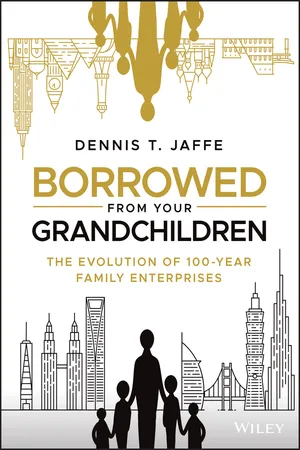
Borrowed from Your Grandchildren
The Evolution of 100-Year Family Enterprises
- English
- ePUB (mobile friendly)
- Available on iOS & Android
About this book
Families share how they have maintained and grown their wealth from generation to generation.
While creating wealth is a wonderful achievement, business families are also concerned with how their wealth is used to support their values, the lives of their children and the well-being of the community. Over several generations, families who are successful in growing their wealth have been able to reinvent themselves and their business in the face of significant environmental transformations and internal differences cause by family dynamics. Borrowed from my Grandchildren is a fascinating look at how large, long-lasting business families succeed across generations.
Author Dennis T. Jaffe, one of the leading architects of the field of family enterprise consulting, has interviewed members of successful, well known, 100-year family enterprises from 20 countries, whoserve as role models for those wishing to see their wealth positively impact their children, employees, and communities. Half continue to own their legacy business and others have gone on to become family offices with a portfolio of shared assets, but all these families have sustained their values and identity as a family over more than three generations.
Offering the collected wisdom of nearly 100 global business families, this insightful book shares the real-life stories of partners in business and wealth management over three of more generations. Families that generate rather than reduce their wealth across generations, known as Generative Families, focus on engaging across generations and develop collaborative governance for both family and business to ensure responsible stewardship from one generation to the next.
This unique resource:
- Presents real-life stories of families sustaining wealth over generations
- Explores both the successes and failures of retaining family wealth
- Includes rare private insights from members of prominent wealthy families
- Examines the nature of global family enterprises and their evolution over generations
- Discusses the financial, human, and social dimensions of wealth
Borrowed from my Grandchildren: The Evolution of Stewardship in 100-Year Families is an essential read for family members, non-family executives, family offices, estate planning lawyers, family business consultants, trust officers, philanthropic and foundation advisors, financial advisors, financial planners, CPAs, and other finance professionals.
Frequently asked questions
- Essential is ideal for learners and professionals who enjoy exploring a wide range of subjects. Access the Essential Library with 800,000+ trusted titles and best-sellers across business, personal growth, and the humanities. Includes unlimited reading time and Standard Read Aloud voice.
- Complete: Perfect for advanced learners and researchers needing full, unrestricted access. Unlock 1.4M+ books across hundreds of subjects, including academic and specialized titles. The Complete Plan also includes advanced features like Premium Read Aloud and Research Assistant.
Please note we cannot support devices running on iOS 13 and Android 7 or earlier. Learn more about using the app.
Information
PART ONE
The Wisdom of Generative Families
CHAPTER 1
Learning from the Best: Researching Long-Term Family Enterprises
What Is a Family Enterprise?
- The first defining quality of a family business is that they are a business where the majority owners share a personal relationship, which usually includes shared values and nonfinancial goals that are as important as making a profit. This bond among the owners makes family business very different than a public corporation where there is no personal link among shareholders.
- A second defining quality of family business is that young family members who are not yet owners are preparing to become owners. Because of their future ownership, they feel some connection to the business, which must be taken into account. The current owners are concerned about their future and take active steps to prepare the future owners for their stewardship. Owners are concerned not with today but with the future; their self-interest is to pass a “gift” to their children, and prepare them to receive it.
- Privately held companies
- Public companies with the family remaining in control
- New ventures started by family members or new businesses bought by the family
- A holding company for multiple family enterprises and assets
- A family office to manage and coordinate family assets and activities
- Trusts that own assets for beneficiaries
- A family foundation for charitable and philanthropic endeavors
Table of contents
- Cover
- Table of Contents
- Foreword: Rice Paddy to Rice Paddy
- Preface
- PART ONE: The Wisdom of Generative Families
- PART TWO: The Evolution of the Resilient Family Enterprise
- PART THREE: Inside the Family: Family Governance to Create a Great Family
- PART FOUR: The Rising Generation: Sustaining the Future
- APPENDIX Tools for Families (and Advisors)
- About the Author
- About the Research Team
- About Wise Counsel Research Associates
- Acknowledgments
- Index
- End User License Agreement